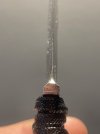Hello, newbie here. I'm getting pretty fair at flat grinding simple knives freehand. I'm trying to learn to move my plunge line back after it's already established. The issue I have is undercut. When I'm using a 60 grit belt and bump the plunge back, as the belt is on the bevel, it's deeper than the ricasso. Instead of cutting the plunge back, the edge of the belt is undercutting the the ricasso.
Should I be lifting the bevel off the belt and grinding straight in to establish the new position for my desired plunge?
Currently I'm leaving the bevel on the belt and bumping toward the plunge, however this method is producing the undercut.
Thank you for any suggestions you may have.
Should I be lifting the bevel off the belt and grinding straight in to establish the new position for my desired plunge?
Currently I'm leaving the bevel on the belt and bumping toward the plunge, however this method is producing the undercut.
Thank you for any suggestions you may have.


